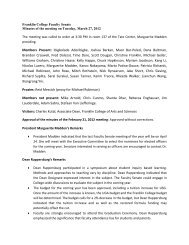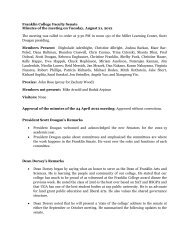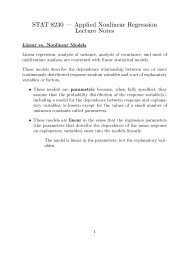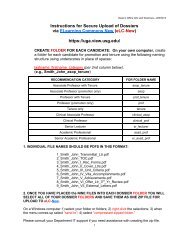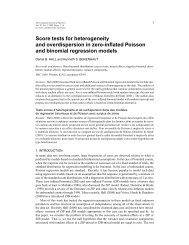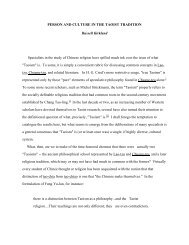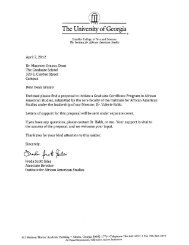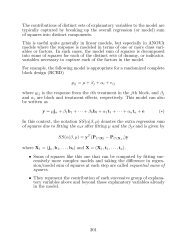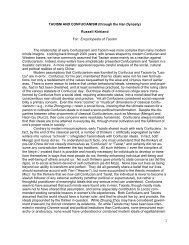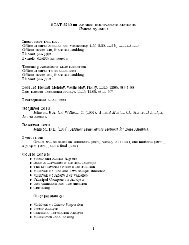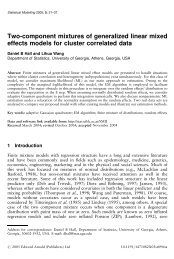Robust Estimation for Zero-Inflated Poisson Regression - Franklin ...
Robust Estimation for Zero-Inflated Poisson Regression - Franklin ...
Robust Estimation for Zero-Inflated Poisson Regression - Franklin ...
Create successful ePaper yourself
Turn your PDF publications into a flip-book with our unique Google optimized e-Paper software.
12 D. B. Hall and J. Shen Scand J StatistTable 5. Frequency distribution <strong>for</strong> use of <strong>for</strong>cecountsCumulativeValue Frequency Per cent per cent0 12,715 94.07 94.071 573 4.24 98.312 151 1.12 99.423 40 0.30 99.724 12 0.09 99.815 13 0.10 99.906 5 0.04 99.947 1 0.01 99.958 1 0.01 99.969 1 0.01 99.9610 2 0.01 99.9812 1 0.01 99.9914 1 0.01 99.9922 1 0.01 100.00Table 6. Parameter estimates and Wald p-values (in parentheses) <strong>for</strong> zero inflated <strong>Poisson</strong>model <strong>for</strong> use of <strong>for</strong>ce counts<strong>Poisson</strong> componentMixing probabilityVariable ML RES ML RESsite – (< 0.001) – (< 0.001) – (0.006) – (0.023)sex – (0.970) – (0.644) – (0.014) – (0.135)race – (0.022) – (0.303) – (0.043) – (0.283)dai – (< 0.001) – (0.076) – (0.001) – (0.110)age 2.16 (0.010) 1.46 (0.261) 3.27 (0.047) 2.39 (0.328)age 2 −2.64 (0.002) −1.91 (0.144) −3.53 (0.036) −2.67 (0.283)priors 0.328 (< 0.001) 0.409 (< 0.001) −0.417 (0.009) −0.293 (0.137)priors 2 −0.0879 (0.188) −0.141 (0.061) 0.240 (0.149) 0.138 (0.406)los 0.248 (0.002) 0.201 (0.038) −1.42 (< 0.001) −1.88 (< 0.001)los 2 −0.0814 (0.051) −0.0442 (0.392) 0.558 (< 0.001) 0.741 (< 0.001)avgutil −0.370 (0.323) −0.281 (0.659) 0.332 (0.600) 0.491 (0.682)avgutil 2 0.175 (0.632) 0.0694 (0.915) −0.472 (0.445) −0.699 (0.573)utildiff −0.0177 (0.908) −0.224 (0.294) −1.52 (< 0.001) −1.72 (< 0.001)utildiff 2 0.122 (0.172) 0.226 (0.061) 1.18 (< 0.001) 1.36 (< 0.001)ML, maximum likelihood; RES, robust expectation-solution.The significant predictors identified in the RES-fitted model largely reproduce those foundby Jackson (2004). In particular, the variable priors is positively associated with the <strong>Poisson</strong>UOF incident rate as is los, which, as should be expected, has a positive influence on the<strong>Poisson</strong> rate of incidents and a significant negative effect on the probability of the zero state.utildiff, which is a measure of the variability in crowding at the detention facility, was alsofound to have a positive influence on the probability of being involved in UOF incidents.The RES results in Table 6 were obtained using tuning constant c = 0.01. In addition, werefit this model using the RES method with c = 0.025 to investigate sensitivity to this choice.Generally speaking, effects of using this larger tuning constant were negligible on parameterestimates and p-values associated with γ. Forβ, the larger c value had slightly greater effects,although mainly on the Wald p-values rather than the parameter estimates. Because the largerc value effectively reduces the estimated variability in the data, p-values tended to drop somewhat,although not drastically; qualitative conclusions about the effects of the explanatoryvariables remain mostly the same, with the only change being to priors 2 and utildiff 2 whosep-values dropped just below the traditional 0.05 significance level.© 2009 Board of the Foundation of the Scandinavian Journal of Statistics.



